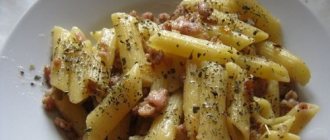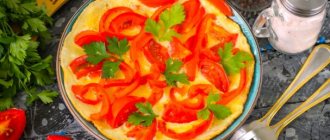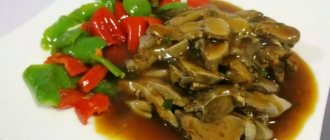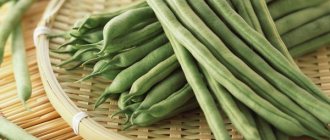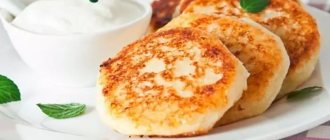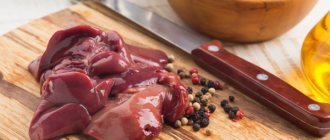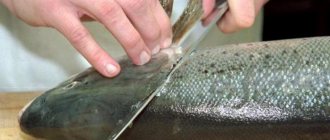Chicken - calorie content, beneficial properties, benefits and harms, description
Calories, kcal:
190
Carbohydrates, g:
0.0
The chicken is the most common domesticated bird; according to some sources, the first attempts to domesticate wild jungle chickens could have been three thousand years BC. Chickens fly little and low, so the birds' wings are not strong, and their legs are better developed. The weight of a chicken carcass ranges from 800 grams to 2.5 kg or more, it depends on the age and breed of the chicken.
Chicken meat is considered dietary, especially the breast, which has an ideal balance of protein and fat. Chicken meat varies in color, the lightest, pale pink is on the breast, the thighs, drumsticks and wings have a darker, pink-brown color. Almost all parts of the chicken are eaten, including chicken giblets (liver, hearts and stomachs), and the legs are added to the broth for jellied meat.
Chicken calories
The calorie content of chicken is 190 kcal per 100 grams of product.
Composition and beneficial properties of chicken
Chicken is a source of easily digestible, high-quality protein, which is necessary for the construction of cells throughout the body and especially muscle tissue. It’s not for nothing that almost all protein diets include boiled chicken breasts in the menu. Chicken meat contains vitamins B and A, as well as potassium, zinc, iron, phosphorus, and is useful for maintaining normal functioning of the cardiovascular system (calorizator). Chicken broth has long been considered the best remedy for a speedy recovery and giving strength after illnesses, normalizing digestive processes. Chicken feet contain a lot of collagen, which is necessary for skin regeneration, so they are added when cooking jellied meat.
Chicken harm
Chicken meat contains one of the dangerous pathogenic microbes - salmonella, which causes a severe intestinal infection, so the chicken must be thoroughly heat treated and rinsed in a large container with cold water before cooking, avoiding running water (splashes on the walls, sink, taps, etc.) .d., will become carriers of salmonella). Campylobacter, which is the causative agent of campylobacteriosis, severe forms of which can cause paralysis, is also found in chicken. Therefore, when purchasing chickens on the market, you must make sure that there is a purple veterinary control seal on the skin of the chicken. Some people suffer from chicken protein intolerance and allergies to chicken meat, so children should introduce chicken into complementary foods with caution.
Selection and storage of chicken
When purchasing chicken, it is recommended to give preference to a chilled product, which, unlike frozen, can be touched and smelled. Fresh chicken should quickly return to its original shape when pressed on any part. The smell of chlorine and rottenness is unacceptable for fresh chicken meat, so you should not buy chicken flavored with aromatic herbs or spices, as unscrupulous sellers often hide the stale product. Domestic chicken usually has a slightly yellowish skin color, this is the specificity of “domestic” chickens.
Store chilled chicken in the refrigerator for no longer than three days or freeze immediately. Frozen chicken can be stored in the freezer for up to 12 months.
Chicken in cooking
Chicken is a versatile product for cooking. Chicken is boiled, fried, stewed, baked and grilled, and is the basis of many soups, salads and appetizers. Chicken meat is used for filling pies, pancakes, dumplings; cutlets, meatballs and pates, and terrines are prepared from chicken. Having a fairly neutral taste, chicken absorbs bright aromas, so it is irreplaceable in pilaf, chakhokhbili or chicken rolls. Look for unusual recipes for cooking chicken in the Recipes section and the article What to cook with chicken.
See more about chicken in the video “Product of the day. Chicken" TV show "About the Most Important Thing!"
Especially for Calorizator.ru Copying this article in whole or in part is prohibited.
Oh, those legs!
The beauty of chicken lies in its softness, tenderness and high cooking speed. In addition, chicken tempts with its affordable price and ease of serving. Chicken legs with skin will complement the daily home menu and decorate the holiday table. Their calorie content will be slightly higher than without the skin. By the way, even a leg with skin can remain dietary if the meat is boiled, steamed or baked without oil. But if you fry them, after marinating them in mayonnaise or any other fatty sauce, then the calorie content of a chicken leg can reach up to 210 calories. This part of the chicken is ergonomic, and therefore the meat becomes an excellent buffet dish and a universal choice for a picnic or barbecue party.
By the way, legs are the most accessible and affordable, even among other parts of the chicken. Because of this, a huge variety of recipes have appeared. A chef can cook legs every day and never repeat the cooking method. The legs are delicious to fry, boil, bake and stew. They also make an excellent base for soups, appetizers or deep-frying.
Chicken - calorie content (how many calories in 100 grams)
Product category
All products Meat Meat from slaughtered animals Meat of wild animals (game) By-products Poultry meat (and offal) Fish Seafood (all categories) Shellfish Crustaceans (crayfish, crabs, shrimp) Seaweed Eggs, egg products Milk and dairy products (all categories) Cheese Milk and fermented milk products Cottage cheese Other milk products Soya and soy products Vegetables and vegetable products Tubers Root vegetables Cabbage (vegetables) Salad (vegetables) Spicy (vegetables) Bulbs (vegetables) Solanaceous Melons Legumes Grains (vegetables) Dessert (vegetables) Greens, herbs, leaves , salads Fruits, berries, dried fruits Mushrooms Fats, oils Lard, animal fat Vegetable oils Nuts Cereals, grains Seeds Spices, seasonings Flour, flour products Flour and bran, starch Bread, flatbreads, etc. Pasta, noodles (pasta) Sweets, confectionery products Fast food Drinks, juices (all categories) Fruit juices and nectars Alcoholic drinks Beverages (soft drinks) Sprouted seeds Vegetarian products Vegan products (without eggs and milk) Products for raw food diet Fruits and vegetables Products of plant origin Products of animal origin High protein products
Nutrient content
Water Protein Fats Carbohydrates Sugars Glucose Fructose Galactose Sucrose Maltose Lactose Starch Fiber Ash Calories Calcium Iron Magnesium Phosphorus Potassium Sodium Zinc Copper Manganese Selenium Fluoride Vitamin ABeta-caroteneAlpha-caroteneVitamin DVitamin D2Vitamin D3Vitamin EVitamin KV itamin CVitamin B1Vitamin B2Vitamin B3Vitamin B4Vitamin B5Vitamin B6Vitamin B9Vitamin B12TryptophanThreonineIsoleucineLeucineLysineMethionineCystinePhenylalanineTyrosineValineArginineHistidineAlanineAsparticGlutamicGlycineProlineSerineTotal of all saturated fatty acidsButyric acid -ta (butanoic acid) (4:0)Caproic acid (6:0)Caprilic acid (8: 0) Capric acid (10:0) Lauric acid (12:0) Myristic acid (14:0) Palmitic acid (16:0) Stearic acid (18:0) Arachidic acid (20:0) Behenic acid (22:0) )Lignoceric acid (24:0) Total of all monounsaturated fatty acids Palmitoleic acid (16:1) Oleic acid (18:1) Gadolinic acid (20:1) Erucic acid (22:1) Nervonic acid (24:1) Total all polyunsaturated fatty acidsLinoleic acid (18:2)Linolenic acid (18:3)Alpha-linolenic acid (18:3) (Omega-3)Gamma-linolenic acid (18:3) (Omega-6)Eicosadiene acid acid (20:2) (Omega-6)Arachidonic acid (20:4) (Omega-6)Tymnodonic acid (20:5) (Omega-3)Docosapentaenoic acid (22:5) (Omega -3) Cholesterol (cholesterol) Phytosterols (phytosterols) Stigmasterol Campesterol Beta-sitosterol (beta-sitosterol) Total trans fats Trans fats (monenoic) Trans fats (polyene) BCAAs Creatine Alcohol Caffeine Theobromine
All about the calorie content of chicken
Chicken meat is a popular food all over the world. It is believed that chickens were first domesticated in India thousands of years ago, primarily for cockfighting and later for meat consumption. Additionally, these meats are part of a variety of culinary traditions, ranging from chicken curry and teriyaki to buffalo wings and barbecue .
Chicken is known for being rich in proteins, nutrients that are very important for the development and maintenance of body functions. Chicken meat is also rich in other nutrients such as vitamins, minerals and fat.
How many calories are in chicken and chicken by-products of different cooking methods?
Chicken soup, chicken stew, chicken breast on a salad - chicken in almost any form is very healthy. Chicken is a lean and low-calorie protein food, making it ideal for weight maintenance. Not to mention, this bird is chock full of essential nutrients and vitamins. But how many calories are in chicken? It all depends on:
- what part of the chicken was cooked;
- how it is prepared;
- how she was prepared.
Different parts of chicken have different levels of fat and cholesterol. When counting the calories in a chicken dish, it's important to consider these factors because there will ultimately be a big difference between one chicken leg and one half chicken breast, or between a fried breast and a grilled one.
Chicken can be called a healthy or unhealthy food depending on the method of preparation . Probably the most famous way to cook chicken is chicken soup, which is especially useful for colds. Fried chicken is clearly not healthy, but boiled chicken is not only tasty, but also healthy. Additionally, the freshness of the chicken also influences the health benefits. Frozen chicken is not healthy because it contains preservatives. But fresh chicken is packed with healthy proteins.
If you are concerned about the number of calories you consume in chicken dishes, remove the chicken skin as it contains a lot of fat.
| How many calories are in whole chicken? | ||
| Chicken product/chicken dish | Calorie content, kcal per 100 grams | Calorie content, kcal per 1 piece. |
| Domestic chicken carcass | 195,09 | 2926 |
| Broiler carcass | 219 | 6570 |
| Chicken carcass | 201,07 | 1053,5 |
| How many calories are in different parts of chicken? | ||
| Chicken product/chicken dish | Calorie content, kcal per 100 grams | |
| Shin (leg) | 177,77 | |
| Quarter (ham) | 181,73 | |
| Hip | 181,28 | |
| Carbonate | 190 | |
| Fillet | 124,20 | |
| Breast | 115,77 | |
| Necks | 166,55 | |
| Wings (wings) | 198,51 | |
| Paws | 130 | |
| Backrests | 319 | |
| How many calories are in chicken by-products? | ||
| Chicken product/chicken dish | Calorie content, kcal per 100 grams | |
| Liver | 142,75 | |
| Hearts (hearts) | 160,33 | |
| Navels | 114,76 | |
| Stomachs (ventricles) | 127,35 | |
| Leather | 206,80 | |
| How many calories are in chicken in different cooking methods? | ||
| Chicken product/chicken dish | Calorie content, kcal per 100 grams | |
| Raw | 191,09 | |
| Boiled | 166,83 | |
| Boiled breast without skin | 241 | |
| Fried | 228,75 | |
| Stewed | 169,83 | |
| Smoked | 184 | |
| Grill | 183,78 | |
| Baked in the oven | 244,66 | |
| White meat chicken broth | 15 | |
| Ground meat | 143 | |
Chicken meat in dietetics and for weight loss
Chicken is one of the best sources of protein and is also suitable for any diet that requires a source of lean meat and protein.
In particular, chicken fillet has beneficial properties. Protein diets are known to be effective in weight loss. Chicken is the main assistant in weight loss, since the meat provides high protein content. Studies and trials have shown that significant weight control has been observed in those people who eat chicken regularly. Proteins in chicken meat help:
- muscle growth and development;
- maintain a healthy body weight;
- lose weight.
Calorie content and recipes for popular dishes with chicken
There are more than 500 recipes for delicious, satisfying, but easy-to-prepare dishes involving fillet. Every traditional cuisine in the world can boast of such a dish. For example, in Japan it is teriyaki and oyakodon , in India it is chicken curry, in China it is stir-fry. Even American nuggets can be prepared without compromising your figure if you replace the bread crumbs with oatmeal.
Caesar with chicken
For the salad:
- 200 g chicken fillet;
- 20 lettuce leaves;
- 8 pcs. Cherry tomatoes;
- a loaf of white bread;
- 50 g parmesan or any other hard cheese;
- 1 clove of garlic;
- a pinch of salt.
Cut the bread into cubes, place on a baking sheet and dry in the oven.
Add vegetable oil to the pan, squeeze out the garlic and fry the croutons in the garlic extract. Fry chicken fillet, rubbed with salt, cool and cut. Soak the salad in cold water for an hour, then tear it up. Cut the cheese into layers. Cut the tomatoes into 4 parts. Place all ingredients in one plate and shake slightly to combine. Place the egg in boiling water for 1 minute and immediately cool in cold water. Break the eggs into a bowl, add mustard, lemon juice and beat, adding olive oil and sauce, salt and pepper.
Serve the sauce separately from the salad.
Calorie content – 232.85 kcal / 100 g.
Light chicken noodle soup
Fill the pan with water and put on fire. Place carrots, peeled onions, and chopped fillets in water. Bring to a boil, reduce heat and add chopped potatoes and bay leaves. Cover with a lid and cook for about 20 minutes. Add noodles, salt, pepper, break the egg and pour into the pan. Cook until the noodles are ready. Turn off and sprinkle with herbs.
The energy value of chicken and noodle soup is 77.90 kcal / 100 g.
Pilaf with chicken
Grate the carrots, chop the onion finely, cut the chicken fillet into cubes. Pour oil into a deep saucepan so that it covers the bottom. Add onions, carrots and let soften. Add the chicken and stir for 3 minutes until the meat is white on all sides. Pour 2 tbsp. water, salt and pepper. Add rice, reduce heat and wait until the water evaporates. Sprinkle with cumin, cover with a lid, turn off the heat and let the rice soak.
Calorie content of pilaf with chicken – 155.94 kcal / 100 g.
Julienne with chicken and mushrooms
- 250 g chicken fillet;
- 200 g mushrooms;
- 1 onion;
- 100 g sour cream;
- 100 g cheese;
- salt pepper.
Finely chop the chicken, mushrooms and onions and mix. Make cocotte bowls from foil. Place the chicken mixture, place the onion on top, brush with sour cream and add grated cheese. Place in the oven at 180 degrees for an hour.
Calorie content – 140 kcal / 100 g.
Chicken kebab and its calorie content
- 700 g chicken thighs without skin;
- 1 liter of kefir;
- salt pepper.
Place the thighs in a bowl, pour in kefir and stir. Add spices and mix again. Place in the refrigerator overnight or for 3 hours. Kefir has the property of softening meat. Grill shish kebab on skewers or skewers.
Calorie content of chicken kebab – 225.47 kcal / 100 g.
Japanese chicken
Beat the chicken fillet, cut into strips and fry over high heat in vegetable oil. Add honey to soy sauce, stir, pour over chicken, salt, pepper and stir. Cover with a lid and simmer for about 5 minutes.
The energy value of Japanese chicken breasts is 107 kcal / 100 g.
Chicken oyakodon recipe
- 300 g chicken fillet;
- 1 onion;
- 1 bunch of green onions;
- soy sauce;
- 2 eggs.
Lightly pound the chicken and cut into strips. Chop the onion. Heat soy sauce in a frying pan, add onion and chicken. Simmer for about 20 minutes. Beat the eggs and pour over the chicken. Cover with a lid and simmer for about 3 minutes. Sprinkle the finished portions with chopped green onions. There is no need to add salt - soy sauce is already salty.
Calorie content – 142 kcal/100 g.
Nutritional value and chemical composition of chicken meat (using the example of chicken breast fillet)
% of the daily requirement indicated in the tables is an indicator indicating how many percent of the daily requirement in a substance we will satisfy the body's needs by eating 100 grams of chicken.
How much protein, fat and carbohydrates (BJU) are in chicken (chicken breast fillet)?
Chicken meat is a real antidepressant, especially chicken soup. Chicken is incredibly high in an amino acid called tryptophan. It gives us a feeling of comfort after eating a portion of chicken dish. If you feel depressed, a poultry dish will increase the level of serotonin in the brain, improve your mood, reduce stress and “lull you to sleep.”
| Substance | Quantity, g (per 100 g of product) | % daily requirement |
| Squirrels | 21,60 | 32 |
| Fats | 10,31 | 14 |
| Carbohydrates | 1,31 | 0,22 |
What vitamins, macro- and microelements are contained in chicken?
Chicken is rich
in phosphorus , an essential mineral that supports teeth and bones, as well as the kidneys, liver and central nervous system. Chicken is also rich in selenium , an essential mineral involved in metabolic performance.
In addition, the abundance of B vitamins and other beneficial substances in chicken help fight arthritis, osteoporosis, heal fractures, restore vision and maintain healthy skin. How often do you cook chicken dishes? Are you maintaining a healthy diet using chicken? Share your experience in the comments .
Taste Factor
The calorie content of a chicken leg allows you to supplement a recipe based on this with a variety of ingredients. Agree, low-calorie meat will harmoniously combine with vegetables, spices, herbs and even fruits! After all, the legs can be cooked with pineapples or apples. The taste will be incredibly original! It’s even easier to chop the drumsticks and lightly sprinkle them with a mixture of pepper and salt. After this, the legs need to be fried in butter and enjoy the taste. No time wasted, but the dish seems truly festive. If the taste is good even in such a primitive recipe, then it is difficult to imagine the extravaganza of aromas in sophisticated dishes!
Calorie content Chicken meat. Chemical composition and nutritional value.
Chicken meat
is rich in vitamins and minerals such as: vitamin B2 - 11.1%, vitamin PP - 39.2%, phosphorus - 17.5%, iron - 11.1%, cobalt - 100%, molybdenum - 22.9 %, chromium - 56%, zinc - 14.2%
- Vitamin B2
is involved in redox reactions, helps to increase the color sensitivity of the visual analyzer and dark adaptation. Insufficient intake of vitamin B2 is accompanied by impaired condition of the skin, mucous membranes, and impaired light and twilight vision. - Vitamin PP
is involved in redox reactions of energy metabolism. Insufficient vitamin intake is accompanied by disruption of the normal condition of the skin, gastrointestinal tract and nervous system. - Phosphorus
takes part in many physiological processes, including energy metabolism, regulates acid-base balance, is part of phospholipids, nucleotides and nucleic acids, and is necessary for the mineralization of bones and teeth. Deficiency leads to anorexia, anemia, and rickets. - Iron
is part of proteins with various functions, including enzymes. Participates in the transport of electrons and oxygen, ensures the occurrence of redox reactions and activation of peroxidation. Insufficient consumption leads to hypochromic anemia, myoglobin deficiency atony of skeletal muscles, increased fatigue, myocardiopathy, and atrophic gastritis. - Cobalt
is part of vitamin B12. Activates enzymes of fatty acid metabolism and folic acid metabolism. - Molybdenum
is a cofactor for many enzymes that ensure the metabolism of sulfur-containing amino acids, purines and pyrimidines. - Chromium
is involved in the regulation of blood glucose levels, enhancing the effect of insulin. Deficiency leads to decreased glucose tolerance. - Zinc
is part of more than 300 enzymes and is involved in the processes of synthesis and breakdown of carbohydrates, proteins, fats, nucleic acids and in the regulation of the expression of a number of genes. Insufficient consumption leads to anemia, secondary immunodeficiency, liver cirrhosis, sexual dysfunction, and the presence of fetal malformations. Research in recent years has revealed the ability of high doses of zinc to disrupt the absorption of copper and thereby contribute to the development of anemia.
morehide
You can view a complete directory of the healthiest foods in the “My Healthy Diet” app.
Why is it worth eating?
Many representatives of the fair sex, who sincerely want to lose weight in a significant amount and as quickly as possible, may come to the conclusion that large legs are not for them, at least temporarily. This point of view is based on the fact that most non-meat products have a lower calorie content, and even a chicken carcass contains dietary parts, for example, the same fillet. But experts do not advise giving up the meat of this bird.
The fact is that chicken (in particular, drumstick) is very beneficial for the human body. For example, this product is a very valuable source of animal protein, of which there are 16 g in each 100-gram serving. If you want to not only lose weight while maintaining all your stretch marks, but also get a toned figure with beautiful muscles, then you cannot exclude such a product from your daily diet.
Considering that most people combine weight loss diets with active sports, constant replenishment of protein reserves is simply necessary.
In addition, chicken drumsticks are a rich source of various minerals, including iron and calcium, magnesium and phosphorus, as well as many other elements. The point of losing weight is often not to eat less, but to establish proper metabolism, which allows you to promptly remove all excess from the body without the formation of unnecessary fat deposits. All of the microelements described above are necessary for good health and the proper functioning of various body systems, so it is possible that weight gain is not so much due to extra calories, but due to the lack of certain minerals. A similar set of substances, of course, is present in pork and beef, as well as in other types of meat, but it is chicken that allows you to get all this with the least amount of fat.
Finally, healthy nutrition experts point to the balanced composition of chicken meat. Thanks to this, it is absorbed much more intensively than other types of meat products. To extract all the benefits from drumsticks, you don’t need to eat kilograms of this product.
